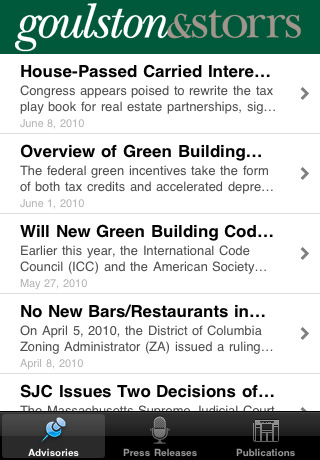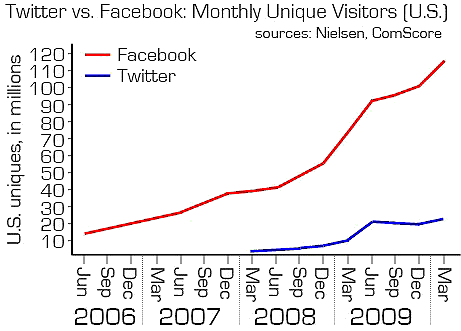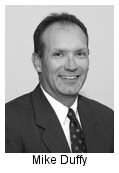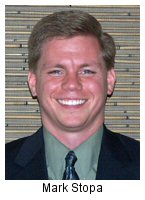Goulston & Storrs Launches iPhone App
 Goulston & Storrs, a 185-lawyer firm headquartered in Boston, launched of its premiere iPhone App. The G&S App offers a convenient way for clients to gather customized information on the most current business topics, directly from an iPhone.
Goulston & Storrs, a 185-lawyer firm headquartered in Boston, launched of its premiere iPhone App. The G&S App offers a convenient way for clients to gather customized information on the most current business topics, directly from an iPhone.
Theresa Bomba, Associate Director of Marketing, remarked, “There are approximately 50 million iPhones currently in use, and with the new launch of the iPhone 4, analysts estimate there will be 100 million iPhone users by the end of 2011. This is an ideal opportunity for us to communicate on a platform which our clients are utilizing. The G&S App will provide meaningful, timely information in a format people prefer.”
 Having worked with the firm I can say that Goulston & Storrs is a very client-centered firm. They really ‘speak the language of the customer,’ communicating with clients via podcasts, client case studies, an online concierge, subscriptions to a wide variety of information – and now an iPhone App. It shows that the firm is not only tech-savvy, but also easy to talk to.
Having worked with the firm I can say that Goulston & Storrs is a very client-centered firm. They really ‘speak the language of the customer,’ communicating with clients via podcasts, client case studies, an online concierge, subscriptions to a wide variety of information – and now an iPhone App. It shows that the firm is not only tech-savvy, but also easy to talk to.
To download the free G&S App, go to the App Store on your iPhone, Keyword: Goulston.
Located in Boston, New York, Washington D.C. and Beijing, Goulston & Storrs is recognized for its quality work and unique service model across multiple service areas.
The firm is famous for its clever award-winning marketing activities, including a Jeopardy game for in-house counsel, its “Gateway to China” campaign for mid-market firms seeking to do business in China, and its creation of a resource center on Legal OnRamp avout the attorney-client privilege.
.jpg) Professional social network LinkedIn now has 70 million members, according to the company’s home page. The company hit 60 million users in February, and has been growing fast, especially in international markets. LinkedIn’s network’s CEO, Jeff Weiner, stated in a blog post last fall that half of LinkedIn’s membership is international. The company is also listing one million company profiles, which are similar to a user profile.
Professional social network LinkedIn now has 70 million members, according to the company’s home page. The company hit 60 million users in February, and has been growing fast, especially in international markets. LinkedIn’s network’s CEO, Jeff Weiner, stated in a blog post last fall that half of LinkedIn’s membership is international. The company is also listing one million company profiles, which are similar to a user profile. Nearly a quarter of households (up 38% year-over-year) have smartphones (mobile phones with advanced operating systems), making it easier for consumers to “place shift” and view the Internet wherever they are, according to the new
Nearly a quarter of households (up 38% year-over-year) have smartphones (mobile phones with advanced operating systems), making it easier for consumers to “place shift” and view the Internet wherever they are, according to the new .jpg)
 I just came from an in-person meeting of a local LinkedIn group I belong to. The speaker was author
I just came from an in-person meeting of a local LinkedIn group I belong to. The speaker was author  "Adding value" is a difficult concept for literal-minded lawyers to wrap their minds around. What is known is that law firms that do add value to a client relationship will get hired over and over again.
"Adding value" is a difficult concept for literal-minded lawyers to wrap their minds around. What is known is that law firms that do add value to a client relationship will get hired over and over again.  Who isn't sick to death about the overload of email? The helpful folks at the ABA's
Who isn't sick to death about the overload of email? The helpful folks at the ABA's .jpg) In-house attorneys are turning away from print sources, and now are using new media platforms to get their legal, business, and industry news and information, according to the new
In-house attorneys are turning away from print sources, and now are using new media platforms to get their legal, business, and industry news and information, according to the new  The number of Americans who use Twitter at least once a month remains relatively small, at 17 million, or about 7% of the total population, according technologist
The number of Americans who use Twitter at least once a month remains relatively small, at 17 million, or about 7% of the total population, according technologist 
 Legal hiring remains a bright spot in a transitional economy, with one-third of attorneys interviewed for The Robert Half Legal Hiring Index indicating they plan to add legal jobs this quarter. Among the findings:
Legal hiring remains a bright spot in a transitional economy, with one-third of attorneys interviewed for The Robert Half Legal Hiring Index indicating they plan to add legal jobs this quarter. Among the findings: When asked whether they have a virtual law office/virtual law practice (i.e., do not typically meet with clients in person, and primarily interact with clients using Internet-based software and other electronic communications software), 14% percent of lawyers surveyed responded affirmatively, according to the new 2010 ABA Legal Technology Survey Report Update.
When asked whether they have a virtual law office/virtual law practice (i.e., do not typically meet with clients in person, and primarily interact with clients using Internet-based software and other electronic communications software), 14% percent of lawyers surveyed responded affirmatively, according to the new 2010 ABA Legal Technology Survey Report Update..jpg)
.jpg)
 How can you tell if a client team is working? Key indicators are:
How can you tell if a client team is working? Key indicators are: Fleming and Chin said that the key measurement is client satisfaction. Chin said Womble will conduct 100 client surveys in 2010 -- 40 done personally by the firm's chairman. "It's difficult to get the chair to find the time, but we're committed to it," he said. "I'm a results-oriented guy. I will ask 'is the client really happy?' "Are we bringing in more work from them?' and 'Is the client willing to go to bat for us and give us a really good reference.' That would be a signature of success."
Fleming and Chin said that the key measurement is client satisfaction. Chin said Womble will conduct 100 client surveys in 2010 -- 40 done personally by the firm's chairman. "It's difficult to get the chair to find the time, but we're committed to it," he said. "I'm a results-oriented guy. I will ask 'is the client really happy?' "Are we bringing in more work from them?' and 'Is the client willing to go to bat for us and give us a really good reference.' That would be a signature of success." Do you have at least mild glossophobia—the fear of public speaking? Lawyers may be less daunted by it than most people because of the nature of our profession. Yet the prospect of speaking to a group of people can raise the heart rate. A 1993 survey identified public speaking as the number-one subject of nightmares.
Do you have at least mild glossophobia—the fear of public speaking? Lawyers may be less daunted by it than most people because of the nature of our profession. Yet the prospect of speaking to a group of people can raise the heart rate. A 1993 survey identified public speaking as the number-one subject of nightmares. There are dozens of poorly thought out web addresses, largely from companies who naively slurred their innocent-sounding names into a single word without noticing the resulting double entendres.
There are dozens of poorly thought out web addresses, largely from companies who naively slurred their innocent-sounding names into a single word without noticing the resulting double entendres. Here's a twist: the recession has clobbered big firms, but it's actually helped drive Fortune 500 clients to small, midsize and boutique law firms, according to a new study by
Here's a twist: the recession has clobbered big firms, but it's actually helped drive Fortune 500 clients to small, midsize and boutique law firms, according to a new study by .jpg) A recent study by Nielson indicates that 30% of smart phone owners are actively using the internet via their phones. This number will surely grow as sales of smart phones exceed sales of computers. It is more crucial than ever that law firms respond proactively.
A recent study by Nielson indicates that 30% of smart phone owners are actively using the internet via their phones. This number will surely grow as sales of smart phones exceed sales of computers. It is more crucial than ever that law firms respond proactively..jpg) 2008 there were 131 million smart phones sold worldwide. By 2013, the number of smart phones sold annually is expected to exceed 1.1 billion, according to the
2008 there were 131 million smart phones sold worldwide. By 2013, the number of smart phones sold annually is expected to exceed 1.1 billion, according to the  Lateral hiring in the legal profession increased 28 percent from April to May — the highest percentage growth since the turn of the calendar year, according to
Lateral hiring in the legal profession increased 28 percent from April to May — the highest percentage growth since the turn of the calendar year, according to  What do Michael Jackson’s mistakes, Marlon Brando’s mess-ups, Frank Sinatra’s faux pas, Jerry Garcia’s gaffes and Leona Helmsley’s lapses in their estate planning have to do with yours?
What do Michael Jackson’s mistakes, Marlon Brando’s mess-ups, Frank Sinatra’s faux pas, Jerry Garcia’s gaffes and Leona Helmsley’s lapses in their estate planning have to do with yours? Florida lawyer
Florida lawyer 


